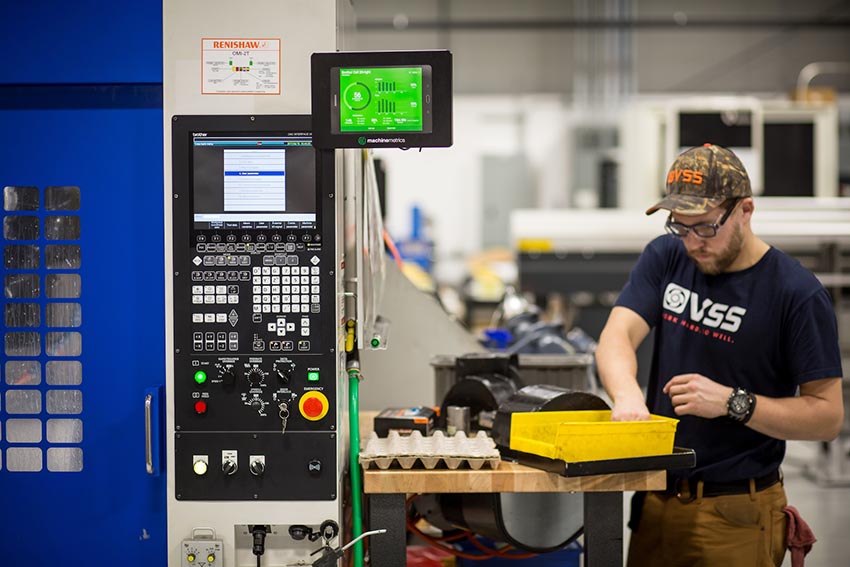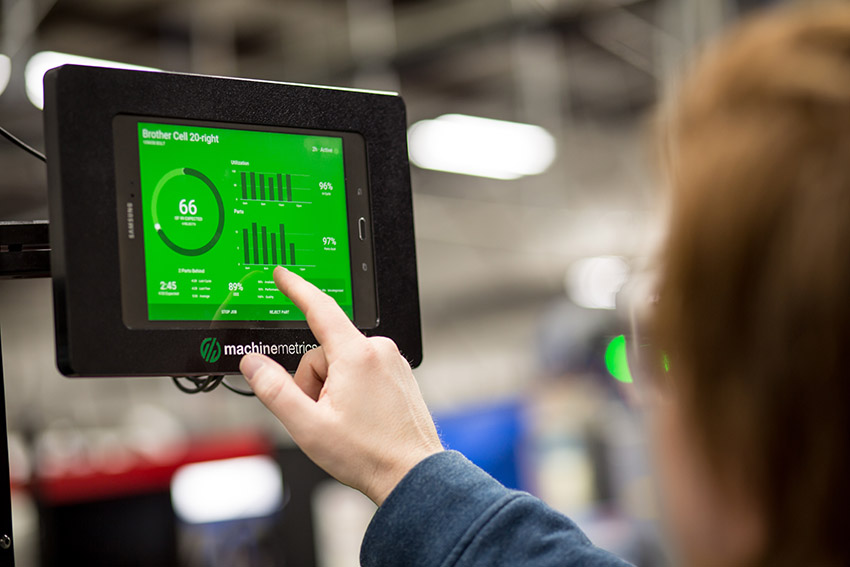MachineMetrics is the operating system for the autonomous factory. Their intuitive and flexible cloud-based Industrial IoT Platform is designed to accelerate a manufacturer’s digital factory transformation via plug-and-play universal manufacturing equipment connectivity, powerful analytics, and intuitive apps for factory workers.
MachineMetrics is quick to deploy, simple to use, and easy to scale across one or multiple factories. Right now, hundreds of manufacturers have connected thousands of machines to reduce equipment downtime and maximize profitability for their operations from anywhere at any time including TE Connectivity, Saint Gobain, Fastenal, Daikin, Regal Beloit, Lincoln Electric, Danfoss, and Hamiton Company.
Out-of-the-box use cases drive instant actionability including real-time production and condition monitoring, historical reporting, text/email notification systems, and configurable automation workflows, that deliver optimized processes to factory workers. Build your own apps, or seamlessly connect MachineMetrics to your other shop floor systems to integrate machine data across your digital factory.
With MachineMetrics, manufacturers can now harness the power of their machine data to significantly expedite time-to-value for Industry 4.0 implementations by putting their data to work immediately while providing the foundation for limitless data-driven automations.
Easy Engineering: What are the main areas of activity of the company?
MACHINEMETRICS: Expansion and extensibility has been our top focuses in 2020 and our expansion is tied directly to our extensibility. MachineMetrics has proven ourselves to be best in class regarding discrete equipment connectivity and analytics platform for manufacturers. Now that we are able to harness what we call “the machine data digital thread”, opportunities for automation become endless, from maintenance, quality, production design, and logistics systems like ERP with real time data and analytics to supply chain for your materials, tooling, and resources, receiving faster customized remote service and customized support from your machine and component providers, to providing greater transparency and traceability to your customers. Our work accomplished in 2020 is a remarkable step forward in enabling flexible actionability on this data for our users.

E.E: What’s the news for 2020 about new products?
MACHINEMETRICS: Two big updates from the product side of things:
MachineMetrics is excited to announce the launch of our groundbreaking new product offering MachineMetrics: Predictive. With MachineMetrics: Predictive, manufacturers can supercharge their predictive analytics applications with high-frequency machine data to diagnose, predict, and avoid failures on your manufacturing equipment without the use of external sensors! ith MachineMetrics: Predictive , manufacturers now have an unprecedented ability to:
Diagnose Machine Problems: Understanding why issues have occurred on machines in the past has been a notoriously difficult task. While low-frequency data can accomplish condition-based monitoring, Trying to do condition-based monitoring on say, spindle load, requires higher fidelity. Collecting high frequency data from the control delivers unprecedented visibility and fidelity into the health and condition of the machine, enabling diagnoses that were once impossible.
Optimize Tool Life: Pushing cutting tools too hard leads to high tooling costs and frequent downtime for changeovers. Not pushing machines may reduce tooling costs at the expense of throughput. An increase in tool wear due to differences in material, environment, and cutting can be detected, allowing you to run your tools to full life every time.
Predict Quality Issues: When tools are compromised, they don’t do their job right. This causes problems like bad finishes and incomplete cuts on parts that must then be scrapped once they make it to QA. Reduce these issues with tool chatter detection. Predict when parts go out of spec before they need to be scrapped or when parts will soon become out of spec.
Predicting Tooling Failures: Expensive tools that snap when they become over-stressed, breaking not only that tool but even those further down the line. Detect when initial stress fractures are occurring in tools, and alert the operator to take them out of commission before it gets worse.
MachineMetrics is focused on making data consumable by manufacturers so they can take action on that data to improve productivity. One way we do this is by providing the technology necessary to create actionable workflows that can automate portions of production and process.
Using MachineMetrics, we are now enabling our customers to merge insights into “Workflows”. These workflows start with insights derived from machine monitoring data which act as triggers to automatically fire off actions- notifications, incidents, or webhooks. Workflows are all about communicating the right information to the right person at the right time. After all, the value realized by data is not just in the discovery of machine or process inefficiencies, but instead in enabling corrective/preventative action that, in the end, improves the operation of the machine.
Once you are able to harness the machine data digital thread, opportunities for automation are endless. Our launch of MachineMetrics Workflows is a remarkable step forward in enabling flexible actionability on this data.

E.E: At what stage is the market where you are currently active?
MACHINEMETRICS: Manufacturing produces more data than any other major industry in the world, yet has been notoriously slow to adopt the digital mindset transforming industries like agriculture, banking, and healthcare.
Due to a lack of data, ever-growing talent shortage, many manufacturers small and large operate mostly on gut instinct alone which leads to remarkable inefficiencies that affect every component of a company’s operation from significant downtime and production losses. In fact, we can tell you that the average utilization of manufacturing equipment hovers around a staggeringly low 23%. It’s jaw dropping really. And, Mounting competition and increasing pressure on pricing have made it even more important for manufacturers to deliver the best product faster than ever, meaning they need help and they need it right now.
Enter IoT, the silver bullet to solve manufacturing’s problems, right? Not exactly. In fact, 81% of IIoT implementations fail (Cisco, 2020) due to the time-consuming and prohibitively expensive nature of implementation and deployment. Not only do they take forever to implement as well as require huge investments up front, but they also lack the required domain/vertical expertise to help the manufacturer transform and take action on the data collected from thousands of different machine types to drive any sort of measurable, quantifiable value to justify the investment, leaving the manufacturer essentially left to fend for themselves. MachineMetrics was founded to solve these problems, to simplify Industrial IoT to digitize the shop floor and enable factories to drive decisions with machine data.
E.E: What can you tell us about market trends?
MACHINEMETRICS: Discrete Manufacturing is the, as Tola Capital put things, “the largest, fastest growing market opportunity for IoT and Cloud investment with the least penetration to date.” This is a market wide open, sort of like the wild west in the best possible ways. We’re now starting to see movement, as COVID-19 has lead many manufacturers to toe conclusion that they not only need remote access to real-time data but they require automation solutions on the factory floor right now.
We have a remote work renaissance on our hands. Even before the outbreak, remote work was on the rise as companies began understanding that remote employees were cheaper and happier. But in light of the quarantine measures, the world has embraced remote work in a way that, while perhaps inevitable, was likely still years away.
Recent Gallup surveys show that up to 62% of people have or are working remotely. 59% of workers who have been working from home during this time would prefer to continue to do so moving forward. For digital companies like us, the impact is significant but manageable. For manufacturing companies, the scenario is indeed more complicated, as many manufacturing processes still require human interaction.
Pair this fact with the fact that Manufacturing has an ever-growing talent shortage. While demand for labor increases, the skills gap in manufacturing may leave approximately 2.4 million positions unfilled between 2018 and 2028 — a potential economic impact of $2.5 trillion.
I think the impact of the above has finally broached the “unignorable” phase for most manufacturers.

E.E: What are the most innovative products marketed?
MACHINEMETRICS: I’m not sure what this question means to be honest. I think a better question would be what are the most practical products being marketed. Most of the “innovative” solutions such as AI, AR, ML-driven predictive maintenance etc. are not currently delivering scalable impact for manufacturers, especially those in the discrete space. I think the most important innovation in our sector right now is vertical solutions that can actually create and sustain value for manufacturers. Low/no-code applications, plug-and-play connectivity all democratize data in a way that has never been possible before, laying the groundwork for true innovation.
E.E: What estimations do you have for 2020?
MACHINEMETRICS: We expect 2021 to be a massive year of growth both for our industry and for our company. COVID-19 has undeniably affected the near term global manufacturing supply chain and economy today and one thing is for certain: it will continue to have global economic and financial ramifications that will be felt throughout the global manufacturing industry. So, the question for this next year is how do we reshape and rebuild an industry both more sustainable and resilient for the future? We believe this will be catalysed through automation adoption, data democratization, and supply chains reorganization into more localized and verticalized forms. If these objectives are achieved, there’s no ceiling for what this next year holds for our industry.
